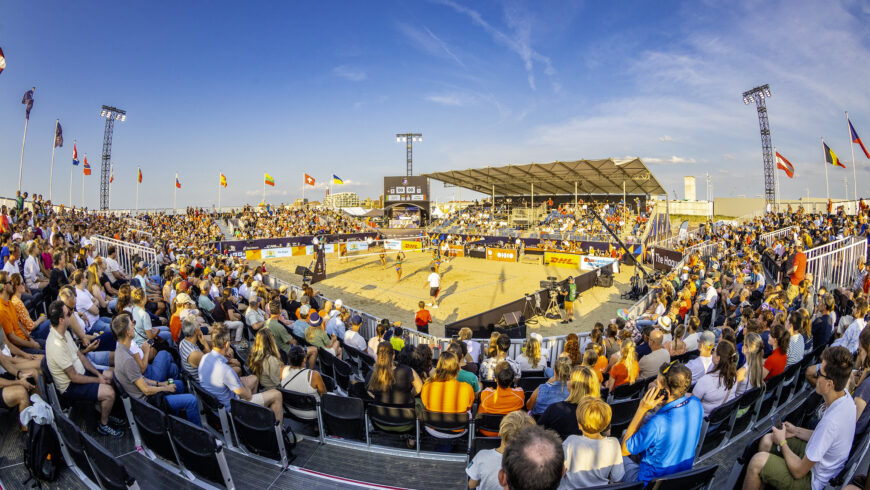EMG Netherlands
- EMG Global
EMG Countries
- EMG Belgium
- EMG France
- EMG Germany
- EMG Italy
- EMG USA
- EMG United Kingdom
EMG Brands

The European Beach Volleyball Championship took place from August 12th to 18th in Arnhem, Apeldoorn, and The Hague. In the latter two cities, EMG provided the broadcast coverage on behalf of Host Broadcaster Southfields.
Project Manager Bart Slijkerman: "In consultation with TV producer Southfields and the local organization, we used our remote solution. This means the directing is done in Hilversum, which could be either from an OB truck or a fixed control room. You only have the camera equipment on the field and a material truck at the event location." The material truck houses conditioned technical racks with audio, intercom, and encoding equipment, which are connected to Hilversum via a network connection. Remote production allows for a more compact setup.
Remote Production
"You use remote production for long-term projects, such as one that lasts a week or more, or for daily recurring programs where fiber connections are available. For instance, if you have a two-year contract and the studio is in Amsterdam, you can easily manage the directing from Hilversum. For an event lasting just a few days, the effort involved may outweigh the savings. That tipping point is crucial," Bart explains. "By having the directing in Hilversum, you need much less space at the event location, and you also reduce parking and accommodation costs." In a remote production, you need the same number of people as you would with on-site directing, but you distribute them differently, which becomes a matter of calculation. Fewer crew members (from EMG and the client) need to be on-site. This approach is not only efficient but also aligns perfectly with our sustainability vision. Under the motto ‘The show must go green,’ we contribute to a greener future with this method.
On the Beach Volleyball Court
Manager of Technology Tom Eshuis and Project Manager David van Leijenhorst handled the preparations, and Bart took over after his vacation. From Apeldoorn and The Hague, a fiber connection was set up to Hilversum. Bart: "The first few days, we handled the coverage in Apeldoorn with four manned cameras and a mini-camera on the game net. A colleague company managed all the matches in Arnhem. For the final matches, we packed up the equipment in Apeldoorn and drove to The Hague, where we continued the production using the same gear." In The Hague, there were seven manned cameras and the mini-camera. "We also had access to the footage from the Hawk-Eye video referee system, which made the broadcasts very dynamic," says Bart. At both locations, in addition to the camera operators, there were three assistants, a connection technician, and a sound technician present. "So, it was a compact team."
At EMG in Hilversum
"As soon as we arrived in The Hague, we connected the material truck to the temporarily installed fiber connection. We immediately had a link to the control room in Hilversum and were able to get started quickly." All signals were sent to Hilversum, where the broadcasts were produced, including the addition of name titles and replays. BOOST Graphics provided the graphics for all TV broadcasts. Bart: "Afterward, our Livecentre took care of global distribution to all recipients, including via fiber and satellite connections."
Both Experienced Parties
Bart enjoys working with Southfields. "We're both experienced parties, and that works well." For directors, remote working can sometimes take some getting used to. "Where you'd normally just walk over to the playing field to say something, now you have to call or use the intercom. That can take some adjusting. There's also a slight delay of about half a second in the signal from the location to Hilversum." Bart enjoys the challenges that arise on location. "Sorting things out on-site is something I always find fun. You never know what you’ll encounter!"
Do you have questions or need information? Fill in your contact details and we'll contact you as soon as possible!
"*" indicates required fields